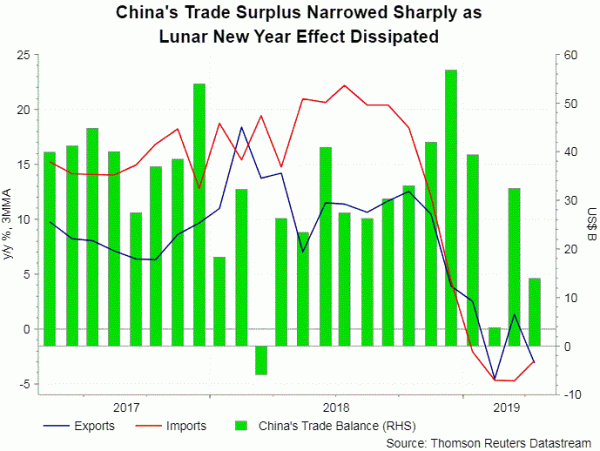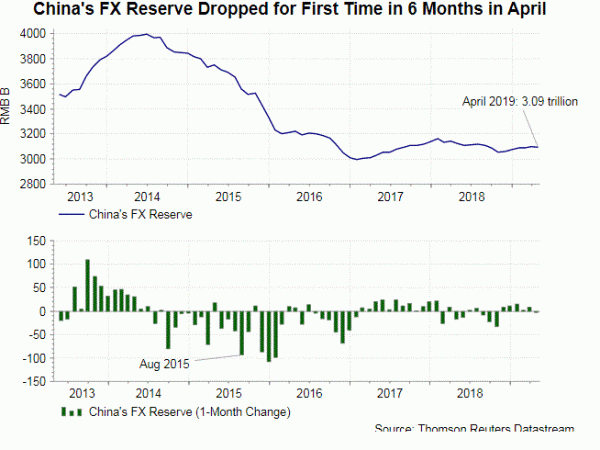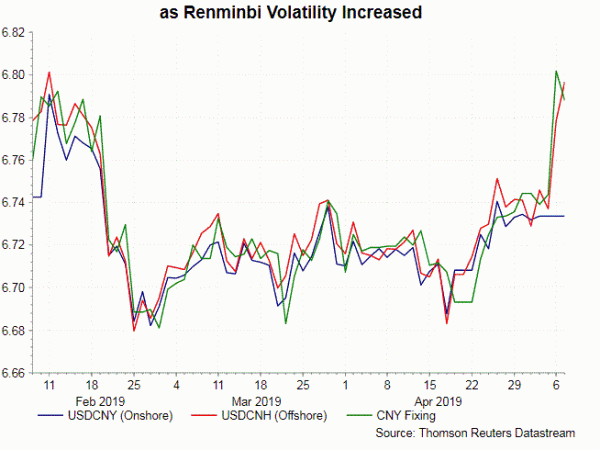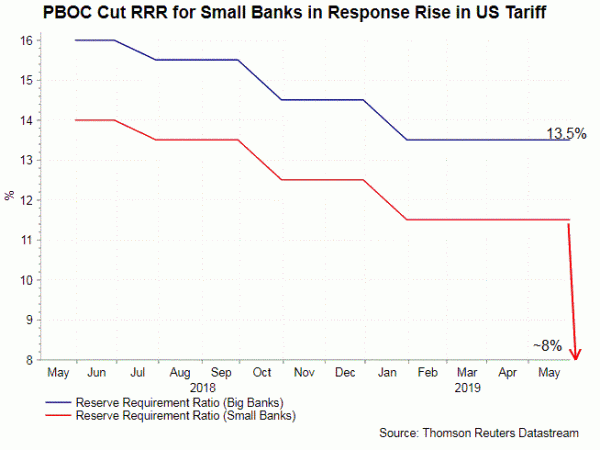Disappointing trade data in China was mainly driven by the large contraction in exports. Instead of merely bilateral trade conflict between the US and China, the broadly based slowdown in exports to China’s major trading partners indicates that global demand is weakening again. Donald Trump’s threat of raising tariff on US$ 200B of Chinese exports to 25% from 10%, if materialized, should cause further deterioration in upcoming trade data. Besides, major macroeconomic data in China would also be negatively affected, forcing PBOC to accelerate its monetary easing stimulus measures.
April Trade Surplus Surprised to Downside
China’s trade surplus narrowed to US$13.8B in April, down -47.2% y/y and -57.3% m/m. This came in significantly below consensus of US$ 35B. Disappointingly, exports contracted -2.7% y/y, proving that the +13.8% jump in March was only driven by Lunar New Year effect. The market had anticipated a mild gained of +3%. Imports rose +4% y/y, compared with consensus of a -2.1% decline. Concerning the battlefield of the recent trade war, China’s trade surplus with the US expanded slightly to US$21B from US$20.5B in March. Exports to US contracted -13.1% y/y while imports from US declined -25.7%.
The contraction in exports was broadly based, suggesting weakness in global demand. Apart from shrinking -13.1% in the exports to the US, shipment to Japan plunged -16.3%. Export growth with EU countries and ASEAN countries decelerated significantly to +6.5% and +0.7%, respectively, from March’s +9.6% and +24.8%. The rebound in imports was mainly driven by commodity demand. This could be explained by the government’s measures to stimulate infrastructure investment and real estate investment.
China FX Reserve
China’s FX reserves fell US$3.81B to US$ 3.095 trillion in April. This marks the first decline in 6 months. Valuation effect (stronger USD) can only be part of the reason for the decline. Greenback’s gain of +1.17% has trimmed the FX reserve by about US$1.6B in the month. PBOC’s intervention to defend renminbi probably explained the remaining US$2.2B reduction. The sharp selloff of renminbi against USD after Donald Trump’s tweet of raising tariff from 10% to 25% signals that PBOC might need to continue to sell FX reserve so as to stabilize its currency.
PBOC announced to cut the reserve requirement ratio (RRR), by about 3 percentage point, for small and medium commercial banks. Expecting to as much as RMB 280B to the interbank market, the reduction would be conducted in 3 phases on May 15, June 17 and July 15. Completion of the move would lower the RRR for a thousand of banks to 8% from the current 10-11.5%. As the central bank noted, the move aims at “helping small- and medium-sized banks to better serve small and private enterprises, which will in turn support the overall economy”. While the market has expected that improvement in economic data in 1Q19 might allow PBOC to put further monetary policy on hold, unsettling trade negotiation with the US would prolong uncertainty in China and global economic developments, forcing PBOC to ease its monetary policy further.















